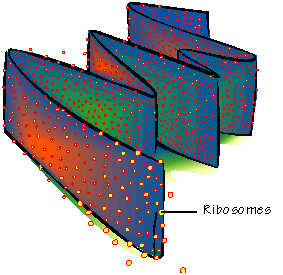Explain brifly Ribosomes, Endoplasmic Reticulum, Golgi Apparatus ?
Ribosomes, Endoplasmic Reticulum, Golgi Apparatus : The cytoplasm contains many ribosomes, which are spherical structures about 20 nm in diameter.
Ribosomes synthesize proteins from information provided by DNA and RNA for export from the cell. They are located on the surface of intracellular membranes called endoplasmic reticulum, or ER.

Mitochondria and chloroplasts also contain ribosomes, which are synthesized within those organelles; these ribosomes are somewhat smaller than those found in the cytoplasm. This observation strengthens the theory that mitochondria and chloroplasts were originally prokaryotic cells--bacteria and blue-green algae, respectively. Prokaryotic cells contain thousands of ribosomes; eukaryotic cells may contain millions. The ribosomes of prokaryotes are also smaller than those in the eukaryote cytoplasm.
Sometimes portions of ER and associated ribosomes are found in pancake-shaped assemblies called the Golgi apparatus.
After the protein is synthesized on the ribosomes of rough ER, it moves to the interior of the pancake assembly. It is then processed and packaged by the Golgi apparatus, and transferred to smooth ER, where it is enclosed in a secretory vesicle for transport from the cell.
Some proteins are not exported from the cell, but are used within the cell itself. These are produced by ribosomes that are not associated with the Golgi network.